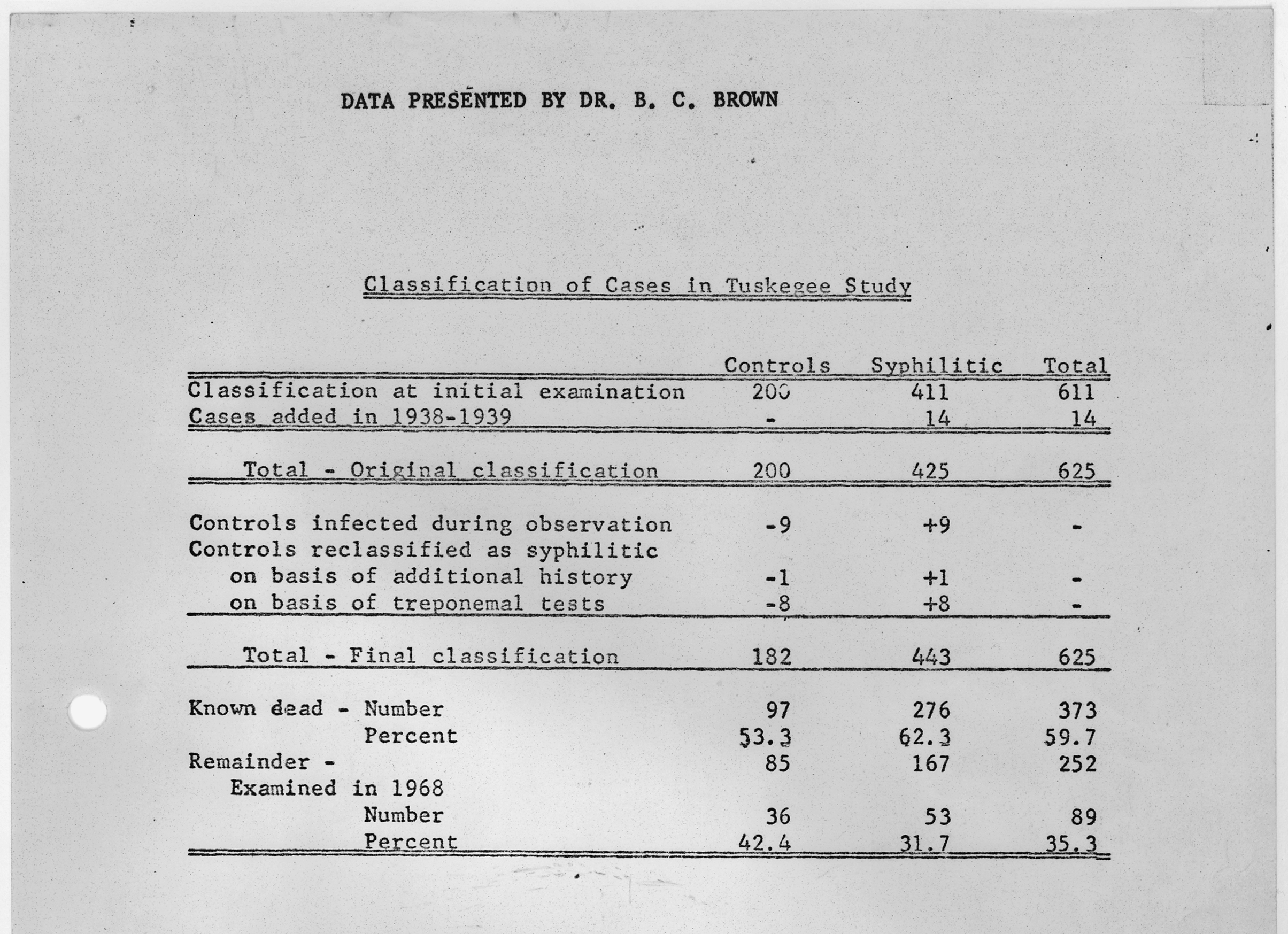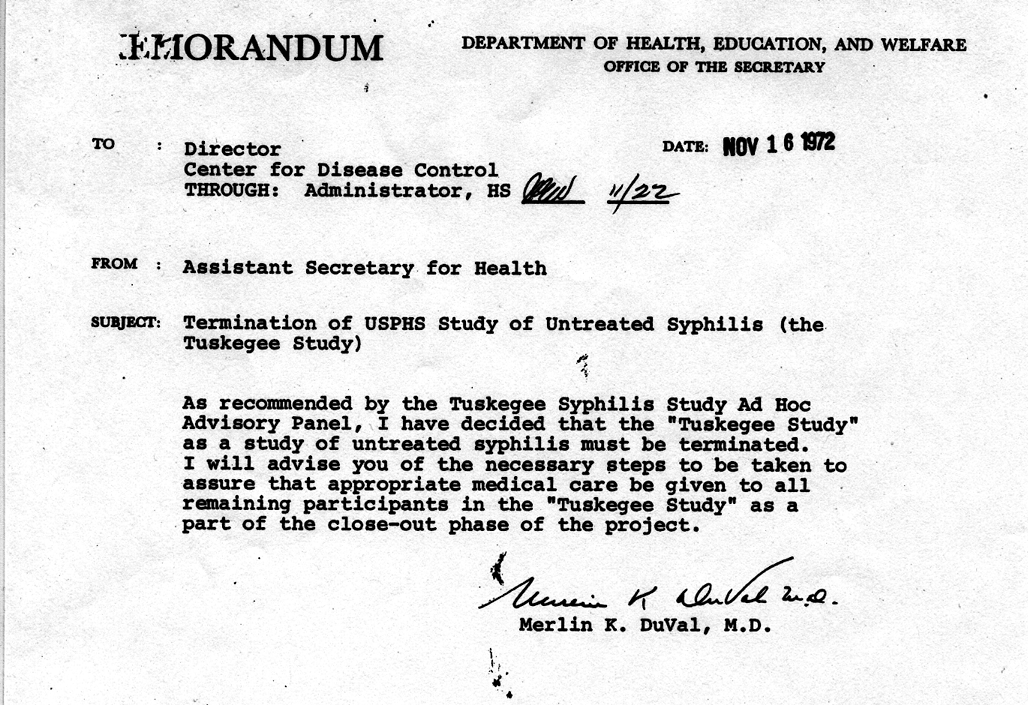Starting in 1932, 600 African American men from Macon County, Alabama were enlisted to partake in a scientific experiment on syphilis. The “Tuskegee Study of Untreated Syphilis in the Negro Male,” was conducted by the United States Public Health Service (USPHS) and involved blood tests, x-rays, spinal taps and autopsies of the subjects.
The goal was to “observe the natural history of untreated syphilis” in black populations. But the subjects were unaware of this and were simply told they were receiving treatment for bad blood. Actually, they received no treatment at all. Even after penicillin was discovered as a safe and reliable cure for syphilis, the majority of men did not receive it.
To really understand the heinous nature of the Tuskegee Experiment requires some societal context, a lot of history, and a realization of just how many times government agencies were given a chance to stop this human experimentation but didn’t.
In 1865, the ratification of the Thirteenth Amendment of the U.S. Constitution formally ended the enslavement of black Americans. But by the early 20th century, the cultural and medical landscape of the U.S. was still built upon and inundated with racist concepts. Social Darwinism was rising, predicated on the survival of the fittest, and “scientific racism” (a pseudoscientific practice of using science to reinforce racial biases) was common. Many white people already thought themselves superior to blacks and science and medicine was all too happy to reinforce this hierarchy.
Before the ending of slavery, scientific racism was used to justify the African slave trade. Scientists argued that African men were uniquely fit for enslavement due to their physical strength and simple minds. They argued that slaves possessed primitive nervous systems, so did not experience pain as white people did. Enslaved African Americans in the South were claimed to suffer from mental illness at rates lower than their free Northern counterparts (thereby proving that enslavement was good for them), and slaves who ran away were said to be suffering from their own mental illness known as drapetomania.
During and after the American Civil War, African Americans were argued to be a different species from white Americans, and mixed-race children were presumed prone to many medical issues. Doctors of the time testified that the emancipation of slaves had caused the “mental, moral and physical deterioration of the black population,” observing that “virtually free of disease as slaves, they were now overwhelmed by it.” Many believed that the African Americans were doomed to extinction, and arguments were made about their physiology being unsuited for the colder climates of America (thus they should be returned to Africa).
Scientific and medical authorities of the late 19th/early 20th centuries held extremely harmful pseudoscientific ideas specifically about the sex drives and genitals of African Americans. It was widely believed that, while the brains of African Americans were under-evolved, their genitals were over-developed. Black men were seen to have an intrinsic perversion for white women, and all African Americans were seen as inherently immoral, with insatiable sexual appetites.
This all matters because it was with these understandings of race, sexuality and health that researchers undertook the Tuskegee study. They believed, largely due to their fundamentally flawed scientific understandings of race, that black people were extremely prone to sexually transmitted infections (like syphilis). Low birth rates and high miscarriage rates were universally blamed on STIs.
They also believed that all black people, regardless of their education, background, economic or personal situations, could not be convinced to get treatment for syphilis. Thus, the USPHS could justify the Tuskegee study, calling it a “study in nature” rather than an experiment, meant to simply observe the natural progression of syphilis within a community that wouldn’t seek treatment.
The USPHS set their study in Macon County due to estimates that 35% of its population was infected with syphilis. In 1932, the initial patients between the ages of 25 and 60 were recruited under the guise of receiving free medical care for “bad blood,” a colloquial term encompassing anemia, syphilis, fatigue and other conditions. Told that the treatment would last only six months, they received physical examinations, x-rays, spinal taps, and when they died, autopsies.

Researchers faced a lack of participants due to fears that the physical examinations were actually for the purpose of recruiting them to the military. To assuage these fears, doctors began examining women and children as well. Men diagnosed with syphilis who were of the appropriate age were recruited for the study, while others received proper treatments for their syphilis (at the time these were commonly mercury- or arsenic-containing medicines).
In 1933, researchers decided to continue the study long term. They recruited 200+ control patients who did not have syphilis (simply switching them to the syphilis-positive group if at any time they developed it). They also began giving all patients ineffective medicines ( ointments or capsules with too small doses of neoarsphenamine or mercury) to further their belief that they were being treated.
As time progressed, however, patients began to stop attending their appointments. To greater incentivize them to remain a part of the study, the USPHS hired a nurse named Eunice Rivers to drive them to and from their appointments, provide them with hot meals and deliver their medicines, services especially valuable to subjects during the Great Depression. In an effort to ensure the autopsies of their test subjects, the researchers also began covering patient’s funeral expenses.
Multiple times throughout the experiment researchers actively worked to ensure that their subjects did not receive treatment for syphilis. In 1934 they provided doctors in Macon County with lists of their subjects and asked them not to treat them. In 1940 they did the same with the Alabama Health Department. In 1941 many of the men were drafted and had their syphilis uncovered by the entrance medical exam, so the researchers had the men removed from the army, rather than let their syphilis be treated.
It was in these moments that the Tuskegee study’s true nature became clear. Rather than simply observing and documenting the natural progression of syphilis in the community as had been planned, the researchers intervened: first by telling the participants that they were being treated (a lie), and then again by preventing their participants from seeking treatment that could save their lives. Thus, the original basis for the study--that the people of Macon County would likely not seek treatment and thus could be observed as their syphilis progressed--became a self-fulfilling prophecy.
The Henderson Act was passed in 1943, requiring tests and treatments for venereal diseases to be publicly funded, and by 1947, penicillin had become the standard treatment for syphilis, prompting the USPHS to open several Rapid Treatment Centers specifically to treat syphilis with penicillin. All the while they were actively preventing 399 men from receiving the same treatments.
By 1952, however, about 30% of the participants had received penicillin anyway, despite the researchers’ best efforts. Regardless, the USPHS argued that their participants wouldn’t seek penicillin or stick to the prescribed treatment plans. They claimed that their participants, all black men, were too “stoic” to visit a doctor. In truth these men thought they were already being treated, so why would they seek out further treatment?
The researchers’ tune changed again as time went on. In 1965, they argued that it was too late to give the subjects penicillin, as their syphilis had progressed too far for the drug to help. While a convenient justification for their continuation of the study, penicillin is (and was) recommended for all stages of syphilis and could have stopped the disease’s progression in the patients.
In 1947 the Nuremberg code was written, and in 1964 the World Health Organization published their Declaration of Helsinki. Both aimed to protect humans from experimentation, but despite this, the Centers for Disease Control (which had taken over from the USPHS in controlling the study) actively decided to continue the study as late as 1969.
It wasn’t until a whistleblower, Peter Buxtun, leaked information about the study to the New York Times and the paper published it on the front page on November 16th, 1972, that the Tuskegee study finally ended. By this time only 74 of the test subjects were still alive. 128 patients had died of syphilis or its complications, 40 of their wives had been infected, and 19 of their children had acquired congenital syphilis.

There was mass public outrage, and the National Association for the Advancement of Colored People launched a class action lawsuit against the USPHS. It settled the suit two years later for 10 million dollars and agreed to pay the medical treatments of all surviving participants and infected family members, the last of whom died in 2009.

Largely in response to the Tuskegee study, Congress passed the National Research Act in 1974, and the Office for Human Research Protections was established within the USPHS. Obtaining informed consent from all study participants became required for all research on humans, with this process overseen by Institutional Review Boards (IRBs) within academia and hospitals.
The Tuskegee study has had lasting effects on America. It’s estimated that the life expectancy of black men fell by up to 1.4 years when the study’s details came to light. Many also blame the study for impacting the willingness of black individuals to willingly participate in medical research today.
We know all about evil Nazis who experimented on prisoners. We condemn the scientists in Marvel movies who carry out tests on prisoners of war. But we’d do well to remember that America has also used its own people as lab rats. Yet to this day, no one has been prosecuted for their role in dooming 399 men to syphilis.
Want to comment on this article? View it on our Facebook page!







